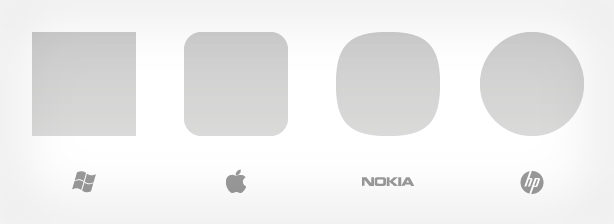June 30, 2011
Own a shape

Visual identity takes many forms, from the most superficial of trademarks to the most integrated of design signatures. Shapes are part of its language. At their most basic, shapes are universal, untetherable to any name, product, or brand. But in context, in their intersections and in the synthesis of forms, they are powerful.
Illustrated above are four shapes: a square, a roundrect, a squircle, and a circle. Bilaterally symmetrical and geometrically simple, each shape’s popular associations are innumerable. Yet in a particular space, the context of a particular market, this is inverted: In the world of mobile software, each of these shapes has a definite association, some quite strong.
To the victor go the squircles
Microsoft’s Metro UI owns the square. Apple has a corner on the roundrect, from the Springboard launcher to the iPhone hardware itself. Nokia, despite its late entry with MeeGo’s Harmattan UI, found the squircle unclaimed and ran with it beautifully. Palm has used the circle from the early days of PalmOS, and in WebOS, HP continues the tradition with care (one might even note that both Palm and HP structure their wordmarks around the circle).
And yet there are pretenders to every throne. Samsung’s Bada may use the square, but it can’t hold a candle to Microsoft’s Mondrian-esque masterwork. RIM may use roundrects pleasantly enough, but not with the subtle consistency Apple does. The lone standout is Android, which doesn’t really have a unifying shape – a symptom of fragmentation?
Like color, which also despite limitless associations has a history of strong associations within a market, shape is a powerful, yet subtle differentiator. Owning a shape isn’t easy – by itself, as demonstrated by Samsung and RIM, a shape is hardly potent. Those who have successfully laid claim to a shape have used it as a building block rather than as window dressing. Use the power of shape to reinforce good design with coherence and identity – and that shape may one day be yours.
Ray writes in with some insights on symmetry, better describing the fundamentality of these shapes:
I thought I would just point out that while all these shapes are bilaterally symmetric, they all exhibit much higher symmetry than that – the first three have four fold and two fold rotational symmetry as well as another mirror plane at 45 degrees to the vertical and the circle has infinite rotational symmetry and mirror planes.
Also, Emanuele Vulcano takes an astute stab at Android’s shape.